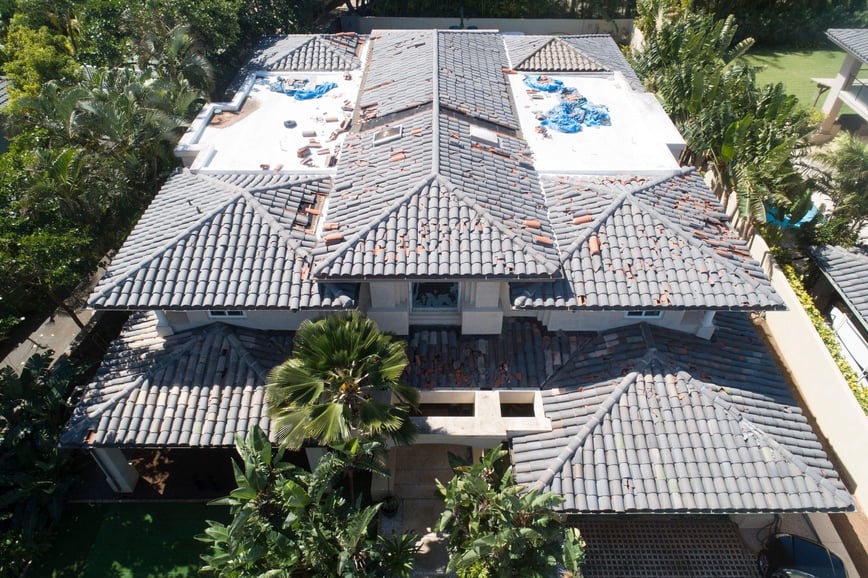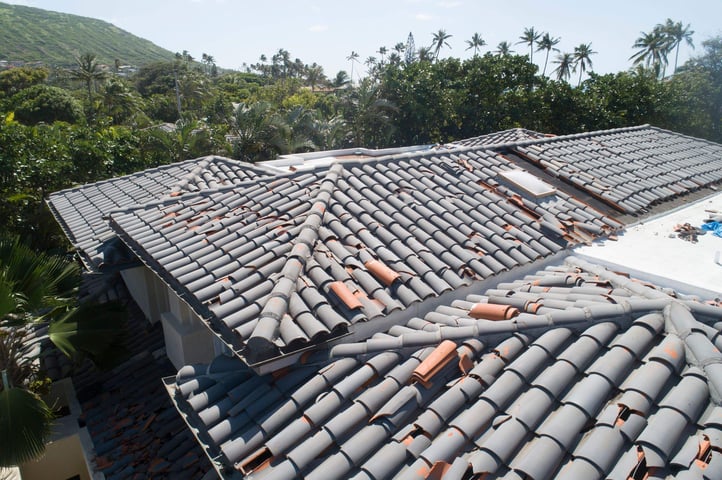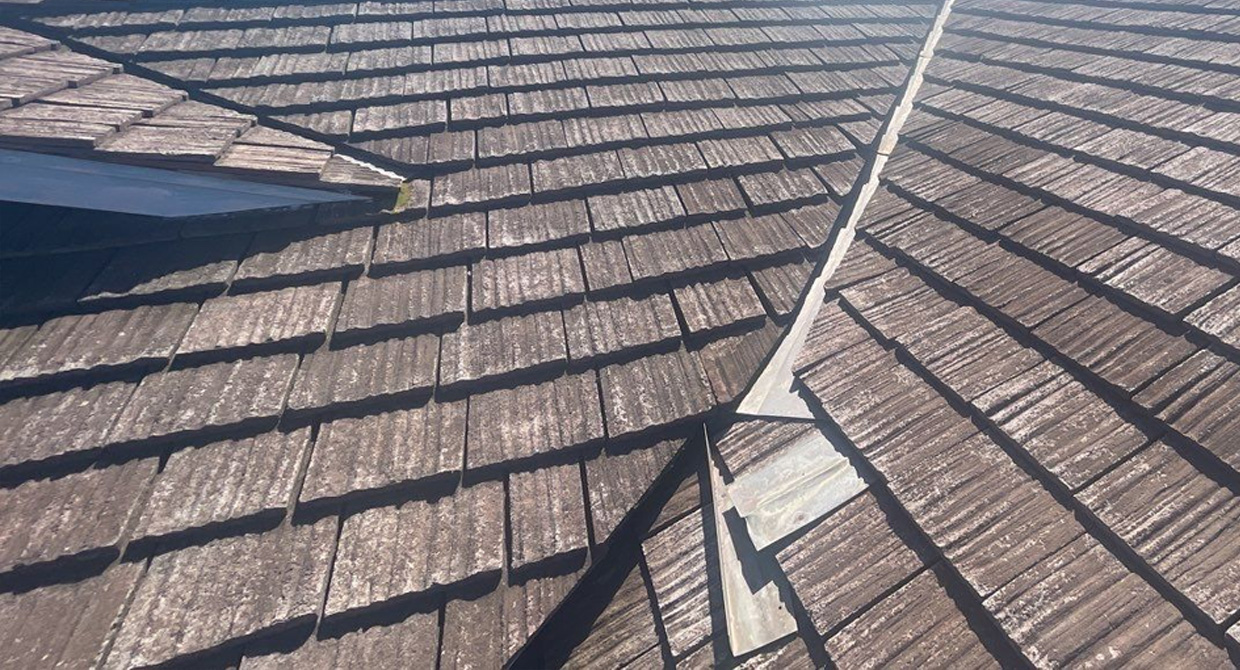If you're a home or building owner looking to install roof tiles onto your structure, you're probably educated on why a tile roof is a good investment. However, it's good to also know what can cause tile roofs to fail prematurely.
A new tile roof can fail prematurely due to the age or integrity of your home structure, poor workmanship, or natural causes.
Tile roofs are popular for many homes due to their visual appeal, durability, and longevity. However, even a tile roof can suffer from wear and tear given the circumstances. From the quality of installation to storm damage, there are several reasons why tile roofs may fail.
By understanding these reasons, homeowners can take the necessary steps to protect their tile roofs and ensure there are no major tile roof problems to face in the future.

How the Age of Your Home Can Impact Tile Roofs
The average lifespan of a tile roof can range from 50 to 100 years or more, but the age of a home can play a significant role in the overall health of a tile roof, and it's important for homeowners to be aware of how the age of their home can impact their roofing system.
The Degradation of Roofing Materials
As homes age, the roofing materials and systems may degrade, which can impact the performance of tile roofs. Over time, the roofs deck or framing system may weaken, causing it to collapse. Additionally, the roof's flashing system may deteriorate, leading to leaks.
The Importance of Regular Inspections
When it comes to tile roofs, it's important to have a professional roofer inspect your roof regularly to ensure its longevity and performance. This will help you identify and address any issues before they become major problems.
The Suitability of Older Homes for Tile Roofs
It's also important to consider the age of your home when choosing a tile roof. If your home is older, it may not be able to support the weight of a tile roof without significant reinforcement. In this case, asphalt shingles or metal are better options.
A professional roofing contractor can advise you on the best course of action to take, depending on the age of your home.
Poor Workmanship / Lack of Experience
One of the most common consequences of poor workmanship on a tile roof is tiles that are not securely fastened. Improperly fastened tiles can shift or become dislodged during high winds, leaving the roof vulnerable to water damage and leaks.
Improper Flashing Techniques
Another critical aspect of tile roof installation is the flashing, which is the process of reinforcing weak points of the roof and roof to wall terminations to prevent water from making its way into your home.
If the flashing is not installed correctly, water can infiltrate your home, causing damage to the interior. Leaks on tiles roofs can be difficult to detect until significant damage has already been done.
Incorrect Tile Selection and Installation
In addition to proper flashing techniques, the selection and installation of roof tiles is also critical. Roof tiles come in a variety of materials and styles, each with unique characteristics and performance requirements. If the wrong type of tile is used or if the tiles are installed incorrectly, the roof can be vulnerable to damage from wind, rain, and other weather conditions.
Improper Roof Underlayment
Another aspect of tile roof installation that is often overlooked is the roof underlayment. The underlayment acts as a barrier between the roof deck and the tiles, protecting your home from water damage. If the underlayment is not installed correctly, water can penetrate the roof, causing leaks and water damage to the interior of your home.
Quality of Roof Tile & Accessories Used
The quality of roof tiles and accessories used is critical to the longevity of a tile roof. Here are some of the ways that poor-quality roof tiles and accessories can cause a tile roof to fail prematurely:
Poor Quality Roof Tiles
Poor quality roof tiles are more likely to crack, break, or become damaged over time. This can lead to leaks and other problems that can weaken the structure of the roof and cause it to fail prematurely. A tile roof repair may cause more damage as roofing contractors will
Flashing and Accessories Failure
Low-quality flashing installed at the roof edge or wall terminations can result in your tile roof allowing water to infiltrate your home and cause other damages to the structure. Poor quality underlayment may shift or deteriorate prematurely.
Weather Resistance
Quality roof tiles and accessories should be designed to withstand extreme weather conditions, such as heavy rain, strong winds, and UV radiation. If the roof tiles or accessories are of low quality and not designed to withstand these conditions, they are more likely to become damaged, which can result in leaks and other problems.
Poor Manufacturing Process
If the manufacturing process for roof tiles and accessories is not rigorous, with quality control measures in place, there is a higher risk of defects, such as cracks, which can lead to failure over time.
What Makes a High-Quality Roofing Tile?
It's important to note that not all roof tiles are created equal. It's essential to choose tiles that are manufactured to industry standards and made from premium materials to ensure that they perform well over the long term and provide the desired level of quality and durability.
-
Clay roof tiles are naturally strong and durable, and high-quality clay tiles are resistant to weathering and UV damage, ensuring long-lasting performance.
-
Concrete roof tiles are known for their strength and durability, and high-quality concrete tiles are designed to withstand harsh weather conditions, including heavy rain and high winds.
Foot Traffic on Tile Roofs
One often overlooked factor is foot traffic on the roof. An excessive amount of foot traffic on a tile roof can lead to shifting or cracked tiles.
Cracked Tiles
Walking on a roof tiles can cause the tiles to crack or chip, which can weaken the structure of the roof and create opportunities for water to penetrate and cause damage. The chips and cracks can also create weak points in the roof, making it more susceptible to damage from extreme weather conditions.
Shifting Tiles
Foot traffic can cause roofing tiles to become loose or dislodged, which can result in leaks and other problems. This can happen because the movement and pressure from walking on the tiles can cause them to shift or become detached from the roofs decking.
Damaged Underlayment
The underlayment is a critical component of tile roofs, as it provides an extra layer of protection between the roof deck and the tiles. Foot traffic can cause the underlayment to become damaged or punctured, which can result in water infiltration and other problems. This can weaken the structure of the roof and cause it to fail prematurely.
Increased Stress on the Roof Structure
Foot traffic can put extra stress on the roof structure, which can weaken it over time and lead to failure. This is especially true if the roof structure is on the older side and not well-maintained. The stress can cause the structure of the roof to become weakened or even damaged, leading to leaks and other problems.

It's important to minimize foot traffic on a tile roof and to avoid walking on the roof altogether whenever possible. If you need to access the roof for maintenance or repair purposes, it's best to use a ladder or scaffolding that distributes the weight evenly and minimizes the impact on the roof.
Roof Tiles Exposed to Extreme Weather Conditions
Tile roofs can typically withstand the elements well, but exposure to extreme weather conditions like heavy rain, wind, hail, and hurricanes can cause damage that can lead to broken tiles and a need for a new roof.
Severe weather conditions can put significant stress on a tile roof and cause it to fail prematurely if it's not properly installed and maintained. Some ways that severe weather conditions can cause a tile roof to fail include:
-
High Winds: High winds can cause tiles to become dislodged or damaged, resulting in leaks and other problems. High winds can also put extra stress on the roof structure, which can cause it to weaken and fail over time.
-
Hail: Hail can cause significant damage to a tile roof, leading to cracks, chips, and other problems. The tiles may need to be replaced, and the underlayment may need to be repaired or replaced, to prevent water infiltration and other problems.
-
Heavy Rain: Heavy rain can cause water to penetrate a tile roof, causing leaks and other problems. A tile roof needs to be installed correctly and with proper workmanship to ensure that it is water-tight and can withstand heavy rain.
-
Extreme Heat: Extreme heat can cause the tiles to expand and contract, which can cause them to become dislodged or damaged. The tiles may also become brittle and break, leading to leaks and other problems.
-
Freezing Temperatures: Freezing temperatures can cause the tiles to become brittle and crack, leading to leaks and other problems. In addition, snow and ice buildup on the roof can put extra stress on the roof structure, which can cause it to weaken and fail over time.

